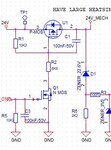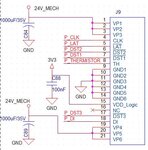tiwari.sachin
Full Member level 6
Hi everyone,
PFA image. The p-mos(U1) remains OFF initially when n-mos(Q1) is OFF. Once, a signal from n-mos(Q1) is sent, the p-mos(U1) turns ON, but, even after turning OFF the n-mos(Q1), p-mos(U1) remains ON. Can anyone say me the reason.., is this because of the capacitors connected to the "24V_mech" line ?? should I change the value of the capacitors??. The p-mos circuit(U1) works fine when it is not connected to "24V_mech" line i.e, it turns ON & OFF for similar signals from n-mos(Q1).
PFA image. The p-mos(U1) remains OFF initially when n-mos(Q1) is OFF. Once, a signal from n-mos(Q1) is sent, the p-mos(U1) turns ON, but, even after turning OFF the n-mos(Q1), p-mos(U1) remains ON. Can anyone say me the reason.., is this because of the capacitors connected to the "24V_mech" line ?? should I change the value of the capacitors??. The p-mos circuit(U1) works fine when it is not connected to "24V_mech" line i.e, it turns ON & OFF for similar signals from n-mos(Q1).


